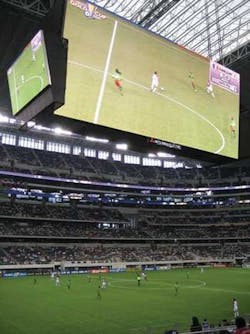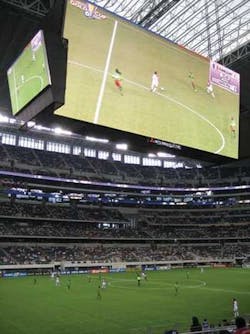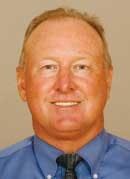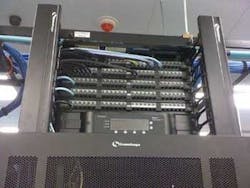Cabling Cowboys Stadium: A five-star facility, Texas style
The team uses fiber and copper to support some of the world's largest-scale technology applications.
When the National Football League's Dallas Cowboys (www.dallascowboys.com) take on their NFC East rival New York Giants on September 20, a national audience will get the opportunity to see the first regular-season football game played at the new Dallas Cowboys Stadium. While millions of viewers will see the stadium for the first time, the months and years of construction leading up to the facility's regular-season openerundoubtedly hold millions of stories.
The stadium itself holds millions of feet of fiber-optic and twisted-pair copper cabling to support technologies that promise to simultaneously dazzle crowds and provide business opportunities for the Cowboys organization.
Exact cost details of the privately funded stadium-construction project may never be fully known, butplenty of detail is available about the cabling infrastructure. CommScope (www.commscope.com) won the contract to provide the stadium's cabling products, including cable and connecting hardware as well as management devices such as racks and enclosures.
In all, the stadium has required more than 5 million feet of CommScope's Systimax copper and fiber-opticcabling, including more than 2.7 million feet ofGigaSpeed X10D Category 6A cable. In several respects, the stadium is an example of twisted-pair cabling's ability to support applications that go far beyond the standard voice and data for which the medium originally became widely deployed. Importantly for the Dallas Cowboys, some of those applications represent revenue-generating business opportunities.
A sure bet
Cowboys owner Jerry Jones, known throughout the NFL and the business world as an unabashed risk-taker, gave every indication he played it safe with his selection ofLayer 1 infrastructure for his new stadium. Before the stadium opened for its first live event—a concert headlined by George Strait on June 6—Jones stated, “The Dallas Cowboys' new stadium will become one of the most visible buildings in the world and, as part of that, weneeded the most advanced communications network we could find—not just for today but also looking into the future. CommScope helped us craft one of thefinest high-performance networks on the planet. We have avision for a place that reflects the emotion and competitionencapsulated by the stadium.”
The years-in-the-making project included a lengthy courtship between CommScope and the Cowboys before the Systimax brand was specified into the facility and actual installation began. CommScope Enterprise Solutions account managerStephen Harrison recalls it as the culmination of about fouryears of effort. “I started by cold calling them, and spoke to their IT manager, who originally said the project was too far down the road. Later, the Cowboys called us looking for a media converter, and the relationship went from there.”
Team representatives visited CommScope's executive briefing center, which because of its location in nearby Richardson, TXwas a convenient local visit for team officials. Once the manufacturer was a serious con-tender for the project, a visit to its manufacturing facility in North Carolina helped clinch the deal.
Harrison recalls the Cowboys as an engaged customer. “Some IT departments and personnel are familiar with Layer 3 and up,” he says, “but they think cable is cable. The Cowboys wanted to know more about the cabling, and we talked to them frequently. We were in touch multiple times per month” during the early stages of the relationship. “One nice aspect of working with the Cowboys organization is they all care,” Harrison continues. The project was nothing like a comparatively simple move into an office building, he emphasizes, and “every time someone would come up with an idea, the whole staff would get engrossed in it.”
Technology equals opportunity
Pete Walsh, the Cowboys' director of technology, oversees the enormity of technological systems that have been incorporated into the facility. A technology that plays a significant role in the stadium's visitor experience is Cisco's StadiumVision. Along with Cisco's Connected Sports Solution, StadiumVision integrates high-definition video, digital content, and interactive fan services into a single network that enhances visitor experience and creates revenue opportunities for the Cowboys.
As part of his long-term planning, Walsh reviewed other sports and entertainment venues worldwide to weigh their characteristics and whether they would work in the Cowboys' new home. “I had a great opportunity over about three years to analyze a lot of technologies and get with a lot of technology companies to understand where their roadmaps were going,” he states. “We looked at a lot of different stadiums around the world to see who was using what. But what made it difficult was scalability. Some arenas had perhaps a couplehundred TVs in them. We have approximately 3,000. Novenue in the world had that many TVs hooked into the StadiumVision application. We knew that with this stadium, foreveryone who would be associated with it, it would be larger than anything anyone had ever attempted before.”
Among the applications made possible through Stadium-Vision are digital signage and displays. Walsh elaborates: “We use several types of digital signage, including menu boards for concession stands. We can generate menus for each stand, send the file to the stadium-apps application, and have it project on the screen over any stand we choose. Because we have multiple screens over each stand, we're likely to fill one or two screens with the name of the stand. There will also be a game feed of what's happening on the field, and probably some sort of advertisement for a food or beverage brand.”
Walsh continues, “Once you move away from the concessions and toward the seating areas, you pass vertical signs on the columns. They can provide directions, or they can be a digital sign for any one of a number of sponsors. The StadiumVision application allows an unlimited supply of inven-tory to sell as advertising.”
A sponsoring organization's message or logo can appear on a sign for five seconds, one minute, any given quarter of a game, either half of the game, the duration of the event—the possibilities are almost limitless, and each represents a potential revenue stream for the Cowboys organization.
“The clubs throughout the facility can be named” using digital signage, Walsh states. “Advertisements can be placed over bars. In any club, there may be 20 to 30 TVs. Each of the IPTVs is individually addressable, so there is an unlimited opportunity for what we'd like to do, from broadcasting other football games, to NASCAR, a golf tournament, or anything else.”
When the facility houses activities other than sporting events, the signage in club areas and concourses can be customized to the host organization's liking. That versatility stands in contrast from the situation at the team's former home, Texas Stadium.
“The old stadium had nothing but static signage,” Walsh says. “When a sponsor purchased a sign, it was there for the duration of the term. We would cover larger signs with tarps or something else when necessary,” such as to cover a sign for alcohol products during a high school football game. In the newstadium, “We can have a high school game Friday night, acollege game Saturday, a pro game Sunday, and a concertMonday,” and allow different sign-sponsorship opportunities for each. Programming the signage requirements for suchrapid-succession events is akin to programming an iPod, he says. “All I'll have to do is hit Play List 1 for the high school game, Play List 2 for the college game,” and so on.
Walsh and the Cowboys decided Category 6A cabling was the right medium for the digital signage and IPTV deployments. “With the IPTV installation we have within the stadium, and the speed requirements for this multicast application, weneeded the ability to run 10-Gbit speeds via copper rather than all TVs being fiber-attached,” he says. “We will also have some 665 point-of-service terminals running over this same cabling, and with the speed requirements for credit card transactions and all other items that are traversing the network wiring, we needed the best and fastest possible cabling solution.”
On the selection of twisted-pair over coaxial cabling for these applications, Walsh notes, “We had to make our best analysis as to where the industry is going. Some were saying go with traditional coax. That's not why Jerry hired me—to do what was traditional. He expects me to be a visionary.”
He continues, “You have two generations: One that grew up on coax, and a new generation with new technology. We think what we're doing is the future, and we're going to go out and prove it. Those who said they'd rather go with tradi-tional coax are missing out on revenue potential, especially on the digital signage. They can't segregate all the TVs into 3,000 individual terminals.”
Y.D. Mullin, technical manager with CommScope Enterprise Solutions, points out that in the technology project's planning stages, consideration was given to the broadcast crews that will move in and out of the facility. “The Cowboys have done everything they possibly could to make the infrastructure as user-friendly as possible, and to prepare for everyapplication so that whenever the media comes in for an event, it is easy for them to have connectivity wherever they need it,” he says. One example of this type of accommodation was to build hangers off the cable tray to facilitate broadcast teams running temporary cables that do not intermingle with the permanent infrastructure.
The stadium has 70 intermediate crossconnects, including one that resides within the center-hung scoreboard. Manufactured by Mitsubishi, the board is a light-emitting diode (LED) display that contains 30 million LED lights. It spans 60 yards, from one 20-yard line to the other. “Mitsubishi built and tested the board,” Walsh says. “We've had a lot of discussion about how we're going to use it during a football game. Once everything is in place, it's like another TV; we can break it into sections if we want to, with football stats on one side, other games in a corner.” He describes the board an“unbelievable” asset during the concerts and soccer games that were among the first events in the facility.
Walsh says he originally considered simply running fiber-optic cabling to the scoreboard, but ultimately decided it was worthy of its own telecommunications room. With 70 crossconnects, Walsh says he anticipates CommScope's iPatch system easing some management tasks. “The iPatch management system will make cable management much easier moving forward,” he says.
Simplifying troubleshooting
CommScope's Mullin adds, “Monitoring a facility of this scale is massive. Considering how many people will be coming and going, having iPatch monitoringfiber as well as copper ports provides the opportunity to know if anything has been unplugged. iPatch sees any changes to the system and automatically notifies thesystem administrator. That's a benefit the Cowboys will certainly see many years into the future as they use the system.”
Walsh concurs: “With the ability to trace a cable from any closet into the exact port in the data center that it is connected to, it should make troubleshooting some issues much easier.”
As of late July, troubleshooting had not been necessary. Football fans in the Dallas area and in many other parts of the country are hopeful the same will be true for the team throughout their inaugural season in the new Cowboys Stadium.
PATRICK McLAUGHLIN is chief editor of Cabling Installation & Maintenance.



